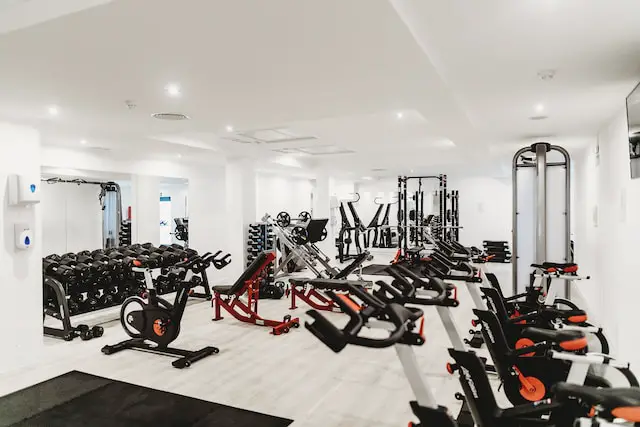Gaining muscle mass involves increasing calorie intake and lifting heavy weights to build muscle size and strength. Getting shredded involves reducing body fat percentage through a combination of calorie deficit, cardio exercise, and weight training.
Gaining muscle mass
(Photo by Arthur Edelmans on Unsplash )

Gaining muscle mass involves increasing overall body weight by building lean muscle through strength training and a calorie surplus. The goal is to consume more calories than you burn so that your body has excess energy to build new muscle tissue. In order to achieve this, it’s important to focus on consuming enough protein – the building block of muscle – along with healthy fats and complex carbohydrates.
Strength training should be focused on compound exercises that work multiple muscles at once, such as squats, deadlifts, bench presses, and pull-ups. These exercises help stimulate maximum muscle growth throughout the body. It’s also important to progressively increase the weight lifted over time for continued gains.
Recovery is crucial when it comes to gaining muscle mass because muscles grow during rest periods between workouts. Aim for 7-9 hours of sleep per night and include rest days in your workout schedule.
While gaining muscle mass can result in some fat gain due to the calorie surplus required, it can ultimately improve metabolic rate and create a stronger physique overall.
Getting shredded
(Photo by Alora Griffiths on Unsplash )

Getting shredded refers to the process of reducing body fat percentage to achieve a lean, defined physique. This involves burning off excess fat while maintaining muscle mass.
To get shredded, you need to be in a calorie deficit by consuming fewer calories than your body burns. A combination of diet and exercise is necessary for effective results.
Your diet should consist of whole foods with adequate protein intake to maintain muscle mass. You will also need to limit carbohydrates and fats while increasing fiber intake.
Resistance training is key in retaining muscle while losing fat. High-intensity interval training (HIIT) can also help burn more calories in less time.
Consistency is essential when getting shredded as it takes time and dedication. Be patient with yourself and focus on progress rather than perfection.
Remember that everyone’s journey towards getting shredded is unique, so don’t compare yourself to others or get discouraged if you don’t see immediate results. Keep pushing forward and trust the process!
Gaining muscle mass Vs. Getting shredded – Key differences
Gaining muscle mass and getting shredded are two different goals that require different approaches to achieve.
Gaining muscle mass typically involves consuming more calories than your body burns to provide the necessary nutrients for muscle growth. This means focusing on strength training exercises that target the major muscle groups in your body, such as the chest, back, legs, and arms, and gradually increasing the weights you lift over time. You also need to ensure that you are consuming enough protein to support muscle growth and recovery.
Getting shredded, on the other hand, involves reducing body fat to reveal the muscle mass that is already there. This requires a focus on calorie restriction and cardiovascular exercise to burn off excess body fat. In addition to a healthy diet, you may also need to supplement your workout routine with high-intensity interval training (HIIT) or other forms of cardio to accelerate fat loss.
In terms of the physical appearance, gaining muscle mass can lead to an increase in overall size and muscle definition, while getting shredded can lead to a more chiseled, toned look with visible muscle striations.
It’s important to note that these goals are not mutually exclusive and can be pursued simultaneously with careful planning and a well-designed training and nutrition plan. However, it’s essential to understand that the approaches and strategies you use to achieve each goal may be different.
How to gain muscle mass
Building muscle mass is not an easy task and requires patience, dedication, and consistency. Here are some tips on how to gain muscle mass:
- Lift heavy weights: This is the most important factor in building muscle mass. Focus on compound exercises such as squats, bench press, deadlifts, and rows.
- Eat enough calories: To build muscles, you need to be in a calorie surplus. Aim for 250-500 extra calories per day above your maintenance level.
- Consume enough protein: Protein is essential for repairing and building muscles after workouts. Aim for at least 1 gram of protein per pound of body weight.
- Get enough rest: Rest days are just as important as workout days because they allow your muscles time to recover and grow.
- Track progress: Keep track of your workouts, food intake, and measurements so that you can make adjustments if needed.
Remember that gaining muscle mass takes time and effort but by following these tips consistently over time will yield great results!
How to get shredded
Getting shredded is all about losing body fat and revealing the muscles you have worked hard to build. Here are some tips on how to achieve that lean, shredded physique:
- Track your nutrition: To get shredded, you need to be in a calorie deficit. This means consuming fewer calories than your body burns each day. Use a food tracking app to ensure you’re hitting your macronutrient targets and staying within your daily calorie limit.
- Lift weights: Strength training helps preserve muscle mass while in a calorie deficit and can even help increase it slightly. Focus on lifting heavy weights with compound exercises like squats, deadlifts, bench press, and rows.
- Incorporate HIIT: High-intensity interval training (HIIT) is an effective way to burn fat while preserving muscle mass. Add some sprints or jump rope intervals into your workout routine.
- Get enough rest: Sleep plays a crucial role in recovery and overall health when trying to shred down for that summer beach bod! Make sure you’re getting at least seven hours of sleep each night.
- Stay consistent: Getting shredded takes time and consistency with both diet and exercise habits – don’t expect results overnight! Keep pushing yourself towards progress one step at a time by making small changes over long periods of time until they become second nature!
Should I shred or gain first?
Deciding whether to shred or gain first depends on your fitness goals, current physique, and overall health status. If you are looking to build muscle mass and increase strength, then gaining should be your priority. On the other hand, if you want a leaner body with defined muscles and lower body fat percentage, then shredding is ideal.
It’s essential to note that both processes require different approaches in terms of nutrition and training methods. When gaining muscle mass, you need to consume more calories than your body burns while lifting heavy weights consistently for progressive overload. In contrast, shredding requires a calorie deficit while engaging in high-intensity interval training (HIIT) or steady-state cardio exercises.
Before deciding which one to pursue first, it’s crucial to assess where you currently stand regarding weight and muscle composition. If you have excess body fat levels above 20% as a male or 25% as a female, then it would be best to prioritize shredding first before attempting bulk up.
Ultimately the choice between shredding or gaining comes down to personal preference based on individual fitness goals. However, keep in mind that both processes require patience consistency over time for optimal results.
Can you shred and still build muscle?
Many people wonder if they can simultaneously shred and build muscle. The short answer is yes, but it’s not easy. Shredding refers to the process of losing body fat while maintaining or building lean muscle mass.
To achieve this goal, you need to focus on two key elements: nutrition and training. Your diet should be high in protein to support muscle growth and low in calories overall to promote fat loss.
In terms of training, you’ll want to prioritize weightlifting exercises that challenge your muscles and help them grow. However, it’s also important to incorporate cardio into your routine for maximum fat-burning benefits.
That being said, shredding and building muscle at the same time requires a delicate balance that can be difficult to achieve without expert guidance. It’s generally recommended that beginners focus on one goal at a time before attempting both simultaneously.
Ultimately, whether you choose to shred or bulk first depends on your individual goals and preferences. Just remember that consistency is key when it comes to achieving any fitness-related objective!
The advantages and disadvantages of bulking and shredding
Bulking and shredding are two approaches to bodybuilding that have their own advantages and disadvantages. Bulking involves eating more calories than you burn with the goal of gaining muscle mass, while shredding is the process of lowering your body fat percentage to reveal your muscles.
One advantage of bulking is that it allows for significant muscle gain, but this often comes at the expense of adding some unwanted fat. Shredding may take longer, but it results in a leaner physique with well-defined muscles.
However, both methods require discipline and consistency. With bulking, there’s a risk of overeating or not getting enough protein which can lead to excess weight gain or less-than-optimal muscle growth. Meanwhile, shredding requires strict diet adherence and intense exercise regimens to lose body fat without sacrificing hard-earned muscle.
Another disadvantage of bulking is that rapid weight gain can cause health problems such as high blood pressure or elevated cholesterol levels. On the other hand, shredding too quickly can result in losing muscle along with fat if done incorrectly.
Both approaches have benefits and drawbacks depending on an individual’s fitness goals and lifestyle habits. It’s important to research what works best for you before committing to either method long-term.
Featured Image By – Humphrey Muleba on Unsplash








